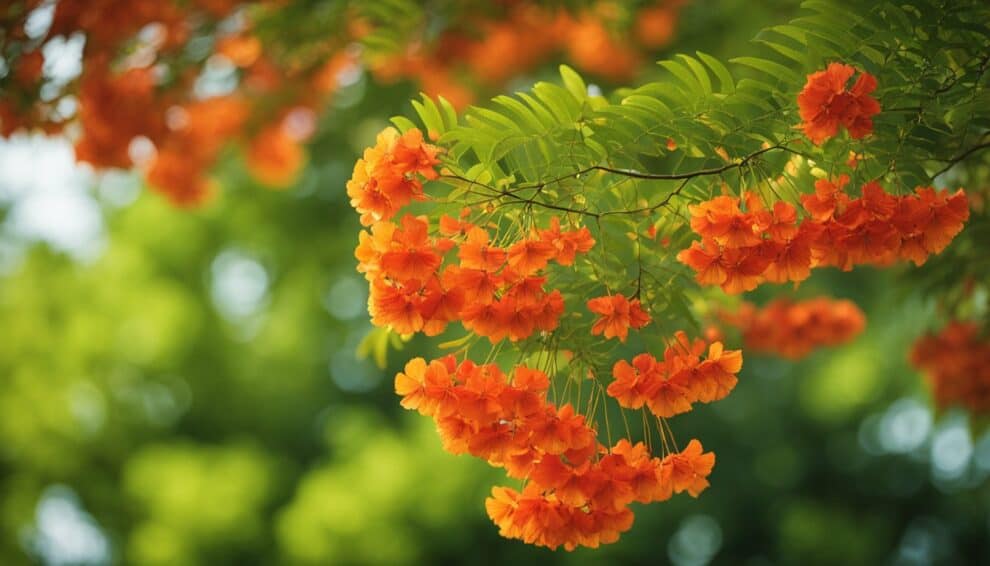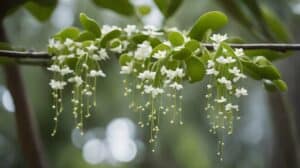Delonix Regia, commonly known as the flamboyant tree, is a tropical plant species native to Madagascar.
It is a popular ornamental tree in many parts of the world due to its stunning display of bright red flowers and lush green foliage.
In this article, we will explore the care and maintenance of Delonix Regia, as well as some interesting facts about this beautiful tree.

One of the most striking features of the flamboyant tree is its showy flowers.
The tree produces large clusters of bright red, orange, or yellow blossoms, which can completely cover the tree’s canopy during the blooming season.
The flowers are followed by long, flat seed pods that can reach up to 60 cm in length.
The flamboyant tree’s leaves are also noteworthy, with their feathery, fern-like appearance and vibrant green color.
Despite its beauty, Delonix Regia requires proper care and maintenance to thrive.
This includes regular watering, fertilization, and pruning to keep the tree healthy and looking its best.
In addition, the flamboyant tree is susceptible to certain pests and diseases, which can be prevented or treated with proper care.
By following these guidelines, anyone can enjoy the beauty of the flamboyant tree in their own backyard.
Understanding Delonix Regia
Origins and Botanical Profile
Delonix Regia, also known as the Flamboyant Tree, is a species of flowering plant in the bean family, Fabaceae.
It is native to Madagascar but can also be found in other tropical regions around the world, including the Caribbean, South America, and Asia.
The Flamboyant Tree is a deciduous tree that can grow up to 12-18 meters tall with a spread of 9-12 meters.
The tree has a unique botanical profile, with its leaves being bipinnate, meaning they are divided into leaflets that are further divided into smaller leaflets.
The leaves are a bright green color and can grow up to 30-50 cm in length.
The flowers of the Flamboyant Tree are large and showy, with five petals that are bright red or orange in color.
They bloom in clusters and can be seen from a distance, making the tree a popular ornamental plant.
Distinctive Features
One of the most distinctive features of the Flamboyant Tree is its trunk, which is thick and wide with a smooth, grayish-brown bark.
The tree also has a wide canopy that provides ample shade and protection from the sun.
The Flamboyant Tree is a fast-growing tree that can reach maturity in just a few years, making it a popular choice for landscaping and shade.
Another interesting fact about the Flamboyant Tree is that it is also known as the Flame Tree or Peacock Flower Tree because of its bright and showy flowers.
In some cultures, the tree is considered a symbol of love and passion.
The tree is also known for its medicinal properties, with its bark and leaves being used to treat various ailments such as fever, diarrhea, and respiratory problems.
In conclusion, the Flamboyant Tree is a beautiful and unique plant that is prized for its ornamental and medicinal value.
Its distinctive features and bright flowers make it a popular choice for landscaping and shade, while its medicinal properties make it a valuable resource for traditional medicine.
Planting and Growing Conditions

Climate Preferences
Delonix regia is a tropical tree that thrives in warm, humid climates.
It can tolerate temperatures as low as 28°F (-2°C) but prefers temperatures between 70°F (21°C) and 100°F (38°C).
The tree is native to Madagascar but has been widely cultivated in tropical and subtropical regions worldwide.
Soil Requirements
The Flamboyant tree prefers well-drained soils that are slightly acidic to neutral.
It can grow in a variety of soil types, including sandy, loamy, and clay soils. However, it does not tolerate waterlogged or poorly drained soils.
The tree has a deep root system that allows it to access water and nutrients from deep within the soil.
Planting Guidelines
When planting Delonix regia, it is important to select a site that receives full sun exposure.
The tree requires at least six hours of direct sunlight per day to thrive.
It is also important to ensure that the planting site is protected from strong winds, as the tree has a shallow root system that can be easily uprooted.
To plant the tree, dig a hole that is twice as wide and deep as the root ball. Gently remove the tree from its container and place it in the hole.
Backfill the hole with soil, taking care not to bury the tree too deeply.
Water the tree thoroughly after planting and continue to water it regularly until it becomes established.
Overall, Delonix regia is a relatively easy tree to grow, provided that it is planted in the right conditions.
With proper care and attention, it can provide years of beauty and enjoyment to its owners.
Maintenance and Care

Watering Schedule
Delonix Regia trees have moderate water requirements, and it is important to ensure that the soil is moist but not waterlogged.
The frequency of watering depends on the climate and soil type.
In general, it is recommended to water the tree every 7-10 days during the growing season and reduce watering during the dormant season.
To determine if the tree needs watering, check the top inch of soil. If it feels dry to the touch, it is time to water.
It is better to water deeply and infrequently rather than shallowly and frequently.
Pruning Techniques
Pruning is an essential part of Delonix Regia tree care.
It helps to maintain the tree’s shape, remove diseased or damaged branches, and promote new growth.
The best time to prune the tree is during the dormant season, which is usually in late winter or early spring.
It is important to use sharp and clean pruning tools to avoid damaging the tree.
When pruning, remove only the branches that are necessary and avoid removing more than one-third of the tree’s canopy.
Fertilization and Nutrition
Delonix Regia trees require regular fertilization to maintain their health and promote growth.
It is recommended to fertilize the tree every 4-6 weeks during the growing season with a balanced fertilizer.
In addition to fertilizer, the tree also requires proper nutrition.
It is important to ensure that the soil has adequate nutrients, including nitrogen, phosphorus, and potassium.
Adding organic matter to the soil can help improve its nutrient content.
Overall, proper maintenance and care are essential for the health and longevity of Delonix Regia trees.
By following a regular watering schedule, pruning techniques, and fertilization and nutrition practices, the tree can thrive and provide a beautiful addition to any landscape.
Pest and Disease Management

Delonix Regia, also known as the flamboyant tree, is a hardy plant that is relatively resistant to pests and diseases.
However, it is still susceptible to a few common issues that gardeners should be aware of.
One of the most common pests that affect flamboyant trees is the mealybug.
These small, white insects feed on the sap of the tree and can cause damage to the leaves and flowers.
To control mealybugs, gardeners can use insecticidal soap or neem oil.
These products should be applied to the affected areas of the tree, taking care to follow the instructions on the label.
Another pest that can affect flamboyant trees is the scale insect.
These insects also feed on the sap of the tree and can cause yellowing of the leaves and premature leaf drop.
To control scale insects, gardeners can use horticultural oil or insecticidal soap.
Again, it is important to follow the instructions on the label when using these products.
In terms of diseases, flamboyant trees can be susceptible to root rot if they are overwatered or planted in poorly draining soil.
To prevent root rot, gardeners should ensure that the soil around the tree is well-draining and that the tree is not watered excessively.
Another disease that can affect flamboyant trees is leaf spot. This fungal disease causes brown spots to appear on the leaves of the tree.
To control leaf spot, gardeners can remove infected leaves and apply a fungicide according to the instructions on the label.
By taking steps to control pests and diseases, gardeners can ensure that their flamboyant trees remain healthy and vibrant for years to come.
Frequently Asked Questions

How do you care for a Flamboyant tree?
The Delonix regia requires full sun and well-drained soil for optimal growth.
Water the tree regularly, especially during the dry season, but avoid overwatering.
Prune the tree to maintain its shape and remove any dead or damaged branches.
What is the best season for flowering in Delonix regia?
The Royal Poinciana tree typically blooms during the summer months, from May to July.
However, the flowering season may vary depending on the climate and location.
What are some common issues with Poinciana trees and how can they be addressed?
The Delonix regia is susceptible to pests such as spider mites and scales, as well as diseases like root rot and leaf spot.
Regular inspection and treatment with appropriate pesticides and fungicides can help prevent and address these issues.
Can you describe the ideal growing conditions for a Royal Poinciana tree?
The ideal growing conditions for a Delonix regia include full sun exposure, well-drained soil, and warm temperatures.
The tree thrives in tropical and subtropical regions with high humidity and rainfall.
What are some interesting uses for the Delonix regia in landscapes or other applications?
The Royal Poinciana tree is commonly used as an ornamental tree in landscapes and public spaces.
Its vibrant red, orange, and yellow flowers make it a popular choice for adding color and beauty to gardens and parks.
The tree’s hard and durable wood is also used for making furniture, flooring, and decorative objects.
How do you propagate Delonix regia from seeds?
To propagate the Delonix regia from seeds, soak the seeds in water for 24 hours to soften the hard outer shell.
Plant the seeds in well-drained soil and keep them moist until they germinate. The seeds typically take 1-2 weeks to sprout.














